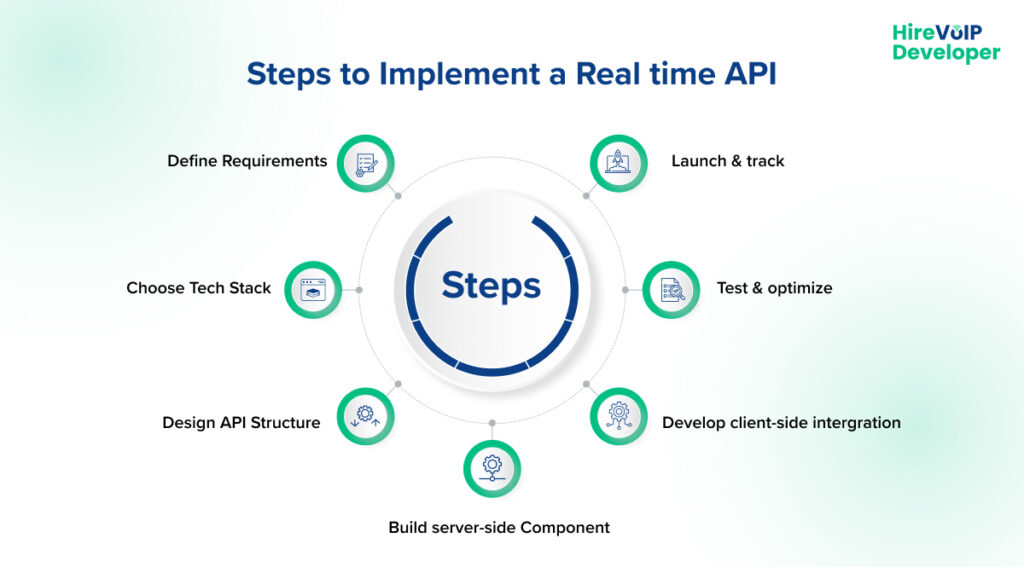Blog Summary: If you want uninterrupted video calls and real-time communication in your app, look into Real-Time APIs. They improve WebRTC by lowering delays, improving performance, and adding smart features like live streaming. Check out this helpful guide to make your app faster and ready for a great real-time communication experience.
Did you notice how video has become a dominant medium for business communication today? And why shouldn’t it? Video is ideal for virtual meetings, team collaboration, and sharing presentations. One of the foundational technologies enabling video communication is WebRTC. This open-source technology allows developers to create web applications that support audio and video communication.
However, some issues, such as connection drops, audio delays, and video freezing, still need to be addressed.
To further improve WebRTC, you can utilize Real-time APIs. These APIs make WebRTC more efficient by reducing latency and delivering information instantly. In this blog, we will look at WebRTC and Realtime APIs. We will understand why they are important and how they can be used in real life. We will also share tips on improving performance and reliability with this technology.
What Are Realtime APIs and WebRTC?
WebRTC (Web Real-Time Communication) is an open-source technology that enables seamless audio, video, and data transmission directly through web browsers, eliminating the need for additional plugins or software. With WebRTC, you can quickly start a video call, share your screen, or work together on a document in real time in your web browser.
Real-time APIs are necessary to manage device interactions to ensure everything works smoothly, like traffic lights coordinating vehicles at an intersection. These ready-to-use APIs enable developers to integrate real-time features into their applications without starting from scratch. With real-time APIs, developers can create instant messaging, live streaming, and collaborative editing.
That’s why integrating real-time APIs with WebRTC is becoming increasingly important for modern applications. As a result, the WebRTC market, valued at approximately $5.5 billion in 2021, is projected to reach $128 billion by 2030, showing a compound annual growth rate (CAGR) of 41.9%.
Why WebRTC Needs Realtime APIs?
Even though WebRTC is powerful, it requires foundational support from Realtime APIs to reach its full potential. Here’s how:
1) Optimizing Signaling: Signaling is important before a WebRTC connection is set up. It involves sharing information about devices, network conditions, and communication methods. If signaling is not done well, calls may fail, connections can be slow, and users might feel frustrated. Real-time signaling for WebRTC is important for providing a reliable and fast communication experience. Real-time APIs help make this process quicker and stronger.
2) Improving Performance: A great engine needs adjustments to achieve the best results. Optimizing WebRTC performance is important for providing a high-quality user experience. Real-time APIs offer tools and methods to improve network traffic, lower delays, and ensure smooth audio and video. They help adapt to changing network conditions, keeping calls stable even under difficult circumstances.
3) Seamless Integration: Integrating the WebRTC API lets developers connect WebRTC with other services, creating new opportunities. Real-time APIs make this easier by adding features like AI transcription, language translation, and sentiment analysis. You can use a real-time API with WebRTC to significantly improve your application’s capabilities.
4) Instant Communication: Today, people expect quick responses. Delays are not acceptable. A WebRTC instant communication API ensures that messages and media are sent with very little delay, offering a real-time experience. This is important for live chat and interactive broadcasting.
5) API-based real-time media streaming: If your application needs to stream video or audio to many people simultaneously, you need an API-based media streaming solution. This helps you scale your application and ensures your users have a good experience.
Here are 10 Live Streaming Apps Using WebRTC for Real-Time Video Broadcasts, you can check.
🔧 Fix latency. Boost stability. Power your WebRTC with real-time APIs.
What Are the Practical Applications of Real-time APIs with WebRTC?
Even though WebRTC is powerful, it requires foundational support from Realtime APIs to reach its full potential. Here’s how:
1) AI-Powered Communication with OpenAI:
It is like a world where your video calls are automatically turned into text, translated, and summarized. Using OpenAI WebRTC and Real-Time APIs, you can add smart features to your communication apps, making them more efficient and easier to use.
2) Building Scalable and Resilient Applications:
Scalability is very important if you’re creating a video conferencing platform or a live streaming service. Real-time APIs give you the tools and support you need to manage many users and high traffic without losing performance.
3) Creating Interactive and Engaging Experiences:
Real-time APIs help you create engaging experiences for users. You can add features like live polls, quizzes, collaborative whiteboards, and virtual breakout rooms to your video calls. The options are endless.
What Are the Best Practices for Using Real-Time APIs with WebRTC?
To build high-performing, real-time communication apps, you need more than just the right tools; you need the right strategy. Here Are Some best practices to maximize the Power of real-time APIs and WebRTC.
 1. Choose the Right API Provider: When choosing a Realtime API provider, it’s important to research and find one that fits your needs. Look for key factors like reliability, scalability, security, and ease of use.
1. Choose the Right API Provider: When choosing a Realtime API provider, it’s important to research and find one that fits your needs. Look for key factors like reliability, scalability, security, and ease of use.
2. Prioritize Signaling: A strong signaling solution is key to a successful WebRTC application. Spend time and effort to improve your signaling setup.
3. Optimize for Performance: Monitor and regularly improve your WebRTC application’s performance. Use real-time APIs to find and fix issues, reduce delays, and improve audio and video quality.
Tools like Kamailio can improve VoIP systems by making signaling easier to manage and allowing for better growth and scalability. For more information, check out our guide on using Kamailio to optimize WebRTC and VoIP systems.
4. Security First: Real-time communication involves sensitive information. Strong security measures are important to protect your users’ privacy and prevent unauthorized access.
💬 Want to deliver seamless video communication? Let’s make it happen.
In summary
Real-Time APIs make WebRTC much better. They improve message delivery, performance, and ease of connection with other technologies, making communication faster and full of features. If you want to create scalable applications, add AI features, or provide engaging user experiences, Realtime APIs will help you use WebRTC to its fullest. Using these APIs and following best practices will help you create smoother and quicker communication solutions that meet customers’ expectations.
We provide skilled WebRTC developers to help you create effective real-time communication solutions.
Whether you want to optimize signaling, improve media streaming, or integrate advanced Real-Time APIs, our team at Hire VoIP Developer has the expertise to help.



